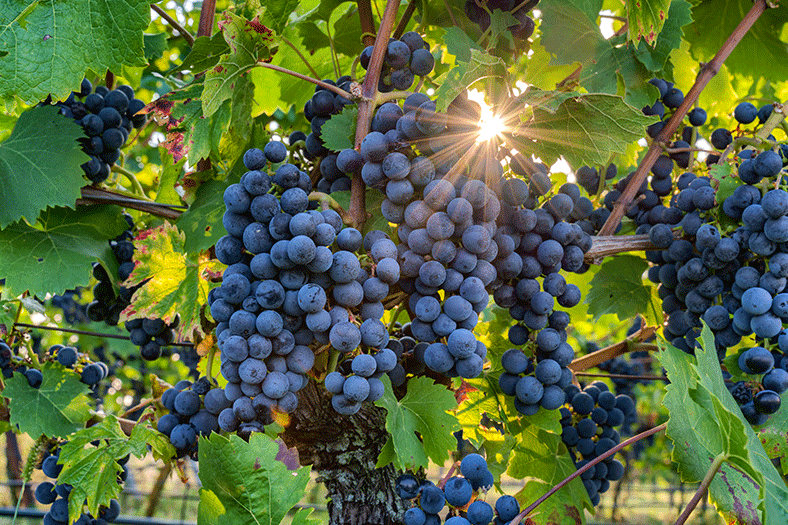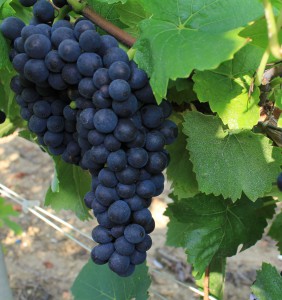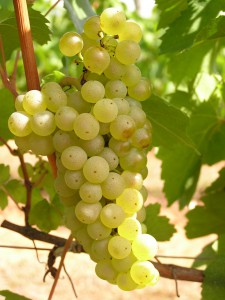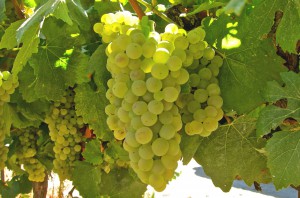
The history of Burgundy’s grape varieties is as rich as it is ancient. Today, we take a closer look at the region’s signature grapes: Pinot Noir, Chardonnay, Gamay and Aligoté. But that’s not all! Burgundy is one of the oldest winegrowing regions in the world, and plays host to several other varieties such as César, Pinot Gris, Sauvignon Blanc, as well as Pinot Beurot, Sacy and Melon…
What is the Burgundy region like?
A common misconception is that there are only two grape varieties in Burgundy. It’s safe to say that there’s a few more than that. We can add two more into the mix, the local variety Aligoté and Gamay, which was once expelled from the region. In fact, many other varieties were historically grown in Burgundy but have gradually disappeared from the landscape and given way to the infamous dominant duo. Among them are Melon de Bourgogne, César, Sacy, and several mutations of Pinot Noir. Burgundy’s vineyards are divided as follows:
- Chardonnay: 48% of the total surface area under vine.
- Pinot Noir: 34%
- Gamay Rouge: 10%
- Aligoté: 6%
- Sauvignon, César, Sacy, Pinot Beurot, Pinot Gris, Melon, etc: 2%
In Burgundy, there are two main families of grape varieties.
The Gouais family
The Gouais family comprises the many varieties resulting from the cross between Pinot Noir (or one of its mutations) and Gouais Blanc. These are the ones that have inherited the most from the Gouais Blanc lineage. Aligoté, Sacy, Gueuche Noir, Muscadelle and Saint-Pierre Doré are some of the members of this family. It’s worth noting that Sacy was previously classified within the Folle family (descended from Folle Blanche), but DNA analysis has since confirmed its lineage from Pinot Noir and Gouais Blanc. So we’ve taken the liberty of reclassifying it within the Gouais family.
The Noiriens family
Pinot Noir is naturally the undisputed head of this family! Other members are Chardonnay, Gamay, Melon, as well as Auxerrois, Franc Noir, Gamay Teinturier de Bouze, Genouillet, Gouget Noir and Troyen.
Overview of Burgundy winegrowing history
Vines have been cultivated in Burgundy for around two thousand years. Some theories even suggest that the region’s vineyards were already well established by the time the Romans arrived. Unfortunately, pinpointing the exact date viticulture first appeared in Burgundy remains a challenge. What is certain, however, is that after the fall of the Roman Empire and the rise of Christianity, Burgundy gained a prominent role in the production of fine wines. The Church not only embraced the symbolic meaning of the vine but also took charge of its production. The founding of the Abbey of Cluny in 910 and the Abbey of Cîteaux in 1098 marked two pivotal moments in the rise and refinement of Burgundy wines. The monks played a decisive role in shaping Burgundy as we know it today, dividing it into clos and climats. The now iconic villages of Aloxe-Corton and Volnay were already highly appreciated by the monks, who gradually expanded the size of their estates. Burgundy wines also already enjoyed considerable success and were produced in several locations. So much so that a royal decree was issued prohibiting their production north of the town of Sens, near Auxerre – a move that can be seen as a forerunner to the concept of Appellation Contrôlée. Whether the vines were owned by dukes, local nobles or monks, producers relied on reputation to sell their wine, and by the 11ᵗʰ and 12ᵗʰ centuries, wines from the same geographical origin, particularly those from clos, enjoyed an excellent reputation. Among these legendary clos, one can already mention, among others, Clos de Tart and Clos Vougeot.
As the quality of Burgundy wines continued to rise, so too did their price. So, peasants began planting vines, which had become far more profitable than wheat. This marked the beginning of a struggle, first by the Duke, then by the King of France, to restore and preserve the quality of Burgundy wines. The Duchy invested heavily in the pursuit of excellence, improving both vine stocks and viticultural practices. In 1395, Philip II, known as Philip the Bold, Duke of Burgundy, issued a decree that laid the foundations for a quality-focused vineyard. His edict banned Gamay, a high-yielding grape variety favoured by the peasantry. It applied to the Burgundy of that time, which did not yet include the Mâconnais region. This edict also championed and recommended the cultivation of Pinot Noir, considered more refined and complex.
In 1660, King Louis XIV, having regained authority over Burgundy, issued a new decree promoting the quality of Burgundy wines, stipulating that “from now on, no vineyard shall be planted on wheat lands or in open fields, but only on hillsides.”
The French Revolution then contributed to reducing the size of the Burgundy vineyard by 25%, and the phylloxera outbreak was another ordeal that had to be contended with. This, however, didn’t prevent the success the region enjoys today!
Burgundy grape varieties
Pinot Noir
History: As you’ve probably gathered, if Pinot Noir is the progenitor of nearly all red grape varieties, it’s precisely because it is one of the oldest. According to Louis Levadoux (French ampelographer, 1912-1985), this is simply due to the fact that Pinot Noir was originally a wild vine brought under cultivation, making it a direct descendant of Vitis vinifera. The history of Pinot Noir is intimately entwined with that of Burgundy, but also with the development of vineyards across the globe. For winemakers worldwide, producing a Pinot Noir wine is the ultimate test of their soil and terroir. There’s more! Its finesse and complexity have made it the red grape most often vinified as a white, playing a key role in crafting Champagne and other sparkling wines.

Geography: Pinot Noir thrives in cool climates and therefore grows in countries with demanding growing conditions such as Germany, Austria, Switzerland, Italy, as well as cooler zones in otherwise warm regions like South Africa, New Zealand, Chile, the United States and Australia. In France, it is the dominant red grape variety in Burgundy and Champagne but is also well represented in Jura and Alsace. Broadly speaking, Pinot Noir can be found, even in minute quantities, in virtually every French appellation producing red wine.
Aromas: When vinified as a red wine, Pinot Noir typically displays a moderately coloured hue, often fairly pale. In their youth, wines reveal notes of red fruits, which develop greater complexity with appellations and age, with the fruit notes deepening into blackcurrant, strawberry and cherry. Kirsch-like nuances emerge, along with floral tones leaning towards violet or peony, and delicate spicy notes (cinnamon, pepper). The tannins are always very fine, at times slightly ‘crunchy’.
When vinified in sparkling white wines, Pinot Noir imparts strength and structure to the blends, where Chardonnay contributes freshness and elegance, and Pinot Meunier adds fragrance and suppleness. Its influence is recognised through fruit-driven notes (ripe apple, Mirabelle, plum and cherry), as well as dried fruits, honey, hints of spice, and occasionally mocha or smoky undertones.
Chardonnay
History: Chardonnay most likely emerged in Burgundy around the 18ᵗʰ century, following a natural crossing between Gouais Blanc and Pinot Noir. It was especially promoted with the introduction of the Appellation d’Origine Contrôlée system in 1935 and has since become the most widely planted white grape variety in the world! Unlike Pinot Noir, Chardonnay is an ‘easy’ variety. It adapts with remarkable ease to almost any climate while retaining finesse and freshness.

Geography: Every wine-producing country in the world grows Chardonnay. In the Americas, this includes the United States, Chile, Argentina and Canada. Elsewhere, it naturally thrives in Australia, New Zealand, South Africa, France, Germany, Italy, Switzerland and Spain.
Aromas: When grown in cooler-climate regions such as Burgundy or Champagne, Chardonnay produces crisp, fresh wines that clearly express their terroir. These wines serve as a faithful reflection of the mineral characteristics of the subsoil. Its aromatic profile typically centres around fresh fruits (lemon, grapefruit, pear), dried fruits (almond, hazelnut), acacia blossom, vegetal nuances (linden, fern), honey, and, of course, a strong mineral streak, often evoking flintstone or chalk.
In warmer climates, such as Languedoc or various New World regions, Chardonnay produces more opulent wines with a golden straw hue. These wines deliver ripe fruit aromas such as pear, apple and even banana, tropical notes like mango, as well as linden blossom and honey. The wines tend to be rounder and more seductive, with less emphasis on freshness and liveliness.
Aligoté
History: Aligoté is the second most planted white grape variety in Burgundy after Chardonnay, and enjoys its own dedicated cru in Bouzeron, in the Côte Chalonnaise. The offspring of Gouais Blanc and Pinot Noir, Aligoté derives from gôt, an old synonym for Gouais Blanc, which it gradually replaced in its native Côte de Beaune.

Geography: France (Bouzeron, Bourgogne Aligoté), Australia, the United States, Romania, Bulgaria, Croatia, Switzerland, and Morocco.
Aromas: Aligoté produces wines with a relatively pale hue and a nose that, while often subtle, offers considerable complexity. Fresh citrus notes such as lemon, alongside green apple, white flowers, vegetal hints and a touch of minerality, all come together on the nose. Freshness and liveliness dominate the palate, producing beautifully acidic wines with plenty of length. These wines are typically enjoyed in their youth, with the exception of a few select ones capable of ageing gracefully.
Gamay

History: As you read in the section on the history of Burgundy above, Gamay didn’t enjoy a great deal of favour with the Duchy. However, despite Philippe the Bold’s edict banning it, Gamay was still produced in Burgundy, especially in the south of the region. Today, it accounts for 10% of the area under vines.
Geography: Gamay is only common in France and a little in Switzerland.
Aromas: Gamay is often synonymous with Beaujolais. When carefully crafted in the Beaujolais crus, Gamay produces wines of moderately coloured intensity and fruity aromas of red fruits (fresh strawberry, cherry, redcurrant), with subtle floral notes and occasional hints of peppery spice. These are very supple wines, generally offering lovely freshness and good intensity that can, when well made, give them red Burgundy wine-like qualities as they age.
Sauvignon Blanc
When someone says ‘Sauvignon Blanc’, most people immediately think ‘Bordeaux’. Well, from now on, you’ll say ‘Saint-Bris’ – a great party trick for wine buffs! Saint-Bris is a Burgundy appellation in the Auxerrois region which produces white wines from Sauvignon grapes.
César
César is an old red grape variety still planted in small pockets across the Auxerrois vineyard, particularly in Irancy. It owes its name to an alleged introduction into France by Julius Caesar, which DNA analysis has since completely ruled out. César is fairly tannic and structured and can be blended with Pinot Noir to enhance its structure and ageing potential. A few hectares of César exist in Chile’s Isla de Maipo. Unfortunately, no one has yet brought back any vine stocks to confirm whether the two are genetically identical.
Melon
Originally from Burgundy, Melon is now rarely used in the region, except occasionally as part of a blend for some Crémants. It’s worth mentioning that Melon is one of very few table grapes used to produce wine.
Sacy
Sacy is a grape authorised as a complementary variety in wines produced in the Saint-Pourçain appellation, alongside Chardonnay and even a little Sauvignon Blanc. It can make up a maximum of 10% of the blend. Used in still wines and Crémants, this variety produces very crisp, low-alcohol wines with pear aromas, making it the ideal candidate for sparkling wine blends.



